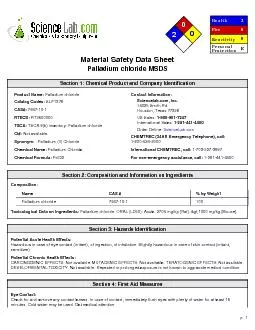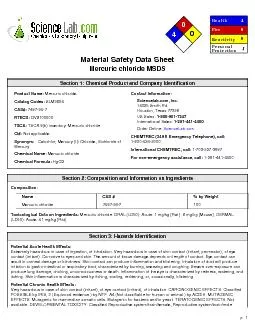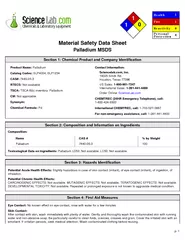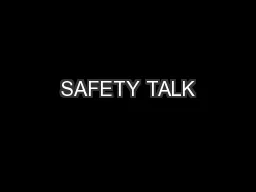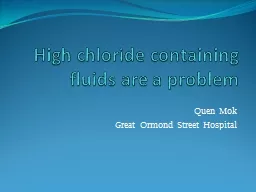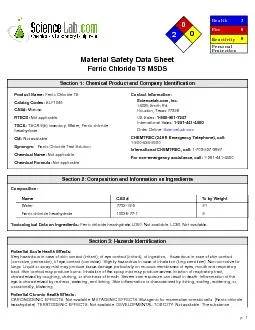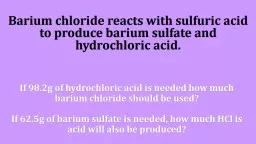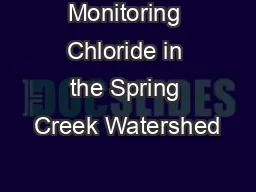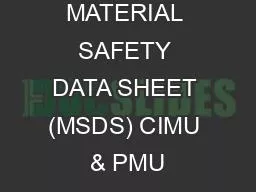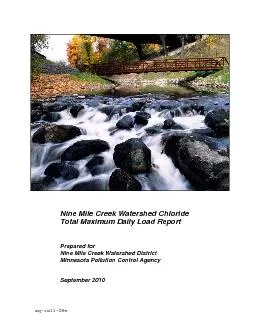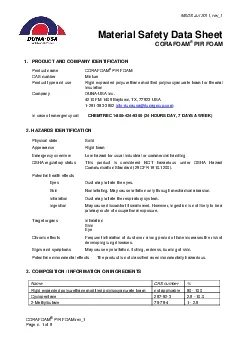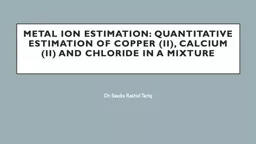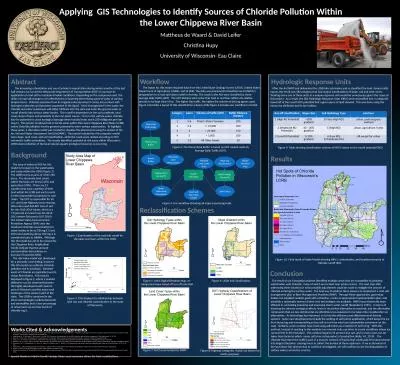PDF-Material Safety Data SheetPalladium chloride MSDS
Author : giovanna-bartolotta | Published Date : 2015-09-19
p 1 0 2 0 Health Fire Reactivity Personal Protection 2 0 0 E Section 1 Chemical Product and Company Identification Product Name Palladium chlorideCatalog Codes SLP1378CAS
Presentation Embed Code
Download Presentation
Download Presentation The PPT/PDF document "Material Safety Data SheetPalladium chlo..." is the property of its rightful owner. Permission is granted to download and print the materials on this website for personal, non-commercial use only, and to display it on your personal computer provided you do not modify the materials and that you retain all copyright notices contained in the materials. By downloading content from our website, you accept the terms of this agreement.
Material Safety Data SheetPalladium chloride MSDS: Transcript
p 1 0 2 0 Health Fire Reactivity Personal Protection 2 0 0 E Section 1 Chemical Product and Company Identification Product Name Palladium chlorideCatalog Codes SLP1378CAS 7647101RTECS RT35000. http://www.msdssource.com - MSDSSource.com is the leading provider of Online MSDS Services. Our customized sites create safer work environments, save time and help lower costs. Let us handle your MSDS Management Service today! p. 1 0 4 0 Health Fire Reactivity Personal Protection 4 0 0 J Section 1: Chemical Product and Company Identification Product Name: Mercuric chlorideCatalog Codes: SLM3604CAS#: 7487-94-7RTECS: OV91000 p. 1 1 1 0 Health Fire Reactivity Personal Protection 1 1 0 E Section 1: Chemical Product and Company Identification Product Name: PalladiumCatalog Codes: SLP4054, SLP1234CAS#: 7440-05-3RTECS: Not ava Hazardous Communication #2. The hazardous communication standard uses two primary ways to communicate the chemical hazards to the employees: the label on the chemical container and the material safety data sheet (MSDS) or safety data sheet (SDS) as GHS is phased in. The following Safety . Quen. . Mok. Great Ormond Street Hospital. Chloride: Queen of electrolytes?. Predominantly excreted by the kidneys. 99% reabsorbed. 60% passively in proximal tubules following active sodium transport. p. 1 0 2 0 Health Fire Reactivity Personal Protection 3 0 0 Section 1: Chemical Product and Company Identification Product Name: Ferric Chloride TSCatalog Codes: SLF1045CAS#: Mixture.RTECS: Not applic If 98.2g . of hydrochloric acid is needed how much barium chloride should be used?. If 62.5g of barium sulfate is needed, how much . HCl. is acid will also be produced?. Barium chloride reacts with sulfuric acid to produce barium sulfate and hydrochloric acid. . Adrienne Gemberling. Water Resource Monitoring Project. Monitoring Purpose. Water Resource Monitoring Project provides . a reasonably accurate description of . quality and quantity of surface and ground waters in the Spring Creek Watershed . For : PT Rentokil Indonesia CIMU&PMU Product Use : Rat Catcher MSDS d ate of preparation : April 6 th , 2018 1. Chemical Product and Company Identification Manufactured : PT. MEGASARI MAKMUR Address Nine Mile Creek Watershed District Minnesota Pollution Control Agency 4700 West 77 th Street Minneapolis, MN 55435-4803Phone: (952) 832-2600 Fax: ( 952 832-2601 Nine Mile Creek Watershed Chlori 1 PRODUCT AND COMPANY IDENTIFICATION Product name CORAFOAM PIR FOAM CAS number Mixture Product type and use Rigid expanded polyurethane modified polyisocyanurate foam for thermal insulation Company DU Dr. Saadia Rashid Tariq. Quantitative estimation of copper (II), calcium (II) and chloride from a mixture. In this experiment the chloride ion is separated by precipitation with silver nitrate and estimated. Whereas copper(II) is estimated by iodometric titration and Calcium by complexometric titration . transmission in the post-synaptic membrane (GABA and glycine channels) [5-7]. In the mouse models, function of aquaporin-6 is also shown to involve chloride transport[7]. Macula densa cells perform th Mattheus de . Waard. & David . Leifer. Christina . Hupy. University of Wisconsin- Eau Claire. . The . increasing urbanization and use of private transportation during winter months of the last half century has forced the Wisconsin Department of Transportation (DOT) to increase its application of road salt to .
Download Document
Here is the link to download the presentation.
"Material Safety Data SheetPalladium chloride MSDS"The content belongs to its owner. You may download and print it for personal use, without modification, and keep all copyright notices. By downloading, you agree to these terms.
Related Documents

